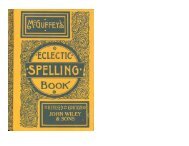WINE, WOMEN, AND SONG. - The Language Realm
WINE, WOMEN, AND SONG. - The Language Realm
WINE, WOMEN, AND SONG. - The Language Realm
You also want an ePaper? Increase the reach of your titles
YUMPU automatically turns print PDFs into web optimized ePapers that Google loves.
IX.<br />
It is easier to say what the Goliardi wrote about than who the writers were, and what they felt and<br />
thought than by what names they were baptised. <strong>The</strong> mass of their literature, as it is at present<br />
known to us, divides[29] into two broad classes. <strong>The</strong> one division includes poems on the themes<br />
of vagabond existence, the truant life of these capricious students; on springtime and its rural<br />
pleasure; on love in many phases and for divers kinds of women; lastly, on wine and on the dice<br />
box. <strong>The</strong> other division is devoted to graver topics; to satires on society, touching especially the<br />
Roman Court, and criticising eminent ecclesiastics in all countries; to moral dissertations, and to<br />
discourses on the brevity of life.<br />
Of the two divisions, the former yields by far the livelier image of the men we have to deal with.<br />
It will therefore form the staple of my argument. <strong>The</strong> latter blends at so many points with<br />
medieval literature of the monastic kind, that it is chiefly distinguished by boldness of censure<br />
and sincerity of invective. In these qualities the serious poems of the Goliardi, emanating from a<br />
class of men who moved behind the scenes and yet were free to speak their thoughts, are unique.<br />
Written with the satirist's eye upon the object of his sarcasm, tinged with the license of his<br />
vagabondage, throbbing with the passionate and nonchalant afflatus of the winecup, they wing<br />
their flight like poisoned arrows or plumed serpents with unerring straightness at abuses in high<br />
places.<br />
<strong>The</strong> wide space occupied by Nature in the secular poems of the Goliardi is remarkable. As a<br />
background to their lovesongs we always find the woods and fields of May, abundant flowers<br />
and gushing rivulets, limetrees and pines and olivetrees, through which soft winds are blowing.<br />
<strong>The</strong>re are rosebowers and nightingales; fauns,[30] nymphs, and satyrs dancing on the sward.<br />
Choirs of mortal maidens emerge in the midst of this Claudelandscape. <strong>The</strong> scene, meanwhile,<br />
has been painted from experience, and felt with the enthusiasm of affection. It breathes of<br />
healthy open air, of life upon the road, of casual joys and wayside pleasure, snatched with<br />
careless heart by men whose tastes are natural. <strong>The</strong>re is very little of the alcove or the closet in<br />
this verse; and the touch upon the world is so infantine, so tender, that we are indulgent to the<br />
generalities with which the poets deal.<br />
What has been said about popular poetry applies also to popular painting. In the landscapes of<br />
Goliardic literature there is nothing specific to a single locality—no name like Vaucluse, no<br />
pregnant touch that indicates one scene selected from a thousand. <strong>The</strong> landscape is always a<br />
background, more northern or more southern as the case may be, but penetrated with the feeling<br />
of the man who has been happy or has suffered there. This feeling, broadly, sensuously diffused,<br />
as in a masterpiece of Titian, prepares us for the human element to be exhibited.<br />
<strong>The</strong> foreground of these pictures is occupied by a pair of lovers meeting after the long winter's<br />
separation, a dance upon the village green, a young man gazing on the mistress he adores, a<br />
disconsolate exile from his home, the courtship of a student and a rustic beauty, or perhaps the<br />
grieved and melancholy figure of one whose sweetheart has proved faithless. Such actors in the<br />
comedy of life are defined with fervent intensity of[31] touch against the leafy vistas of the scene.<br />
<strong>The</strong> lyrical cry emerges clear and sharp in all that concerns their humanity.



